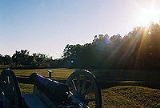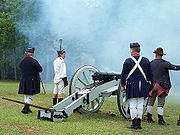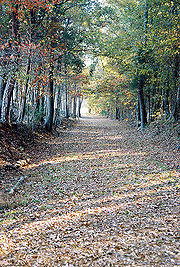
Ninety Six National Historic Site
Encyclopedia
Ninety Six National Historic Site, also known as Old Ninety Six and Star Fort, is a United States
National Historic Site
located about 60 miles (96 kilometers) south of Greenville, South Carolina
. The historic site was listed on the National Register in 1969, declared to be a National Historic Landmark
in 1973, and established as a National Historic Site
in 1976 to preserve the original site of Ninety Six, South Carolina
, a small town established in the early 18th century.
. Supporters of such an etymology are at pains, however, to explain away the fact that the distance between the two locales is in fact 78 miles. David P. George, Jr., has advanced the alternative hypothesis that Ninety Six is in fact a reinterpretation of “the nine and six,” a reference to two sets of southerly flowing streams—nine tributaries of Marion and Henley creeks and six tributaries of Thompsons Creek—in an area in which the trunk stream
tends to be fed by north/easterly flowing streams.
 Ninety Six had become a prosperous village by the time the American Revolutionary War
Ninety Six had become a prosperous village by the time the American Revolutionary War
came knocking at the door. The first land battle of the war fought south of New England
took place at Ninety Six in 1775. The village became a Loyalist
stronghold early in the war and was fortified by the British
in 1780. From May 22 - June 18, 1781, Continental Army
Major General
Nathanael Greene
led 1,000 troops in a siege against the 550 Loyalists in the village. The 28-day siege, the longest of the entire war, centered on an earthen fortification known as Star Fort
. Despite having more troops, Greene's patriots
were eventually unsuccessful in taking the town.
Ninety Six was declared a National Historic Landmark
in 1973.
According to the South Carolina Department of Archives and History, the "historic district of Ninety Six National Historic Site contains numerous historical features."
A special ceremony was held the weekend of May 20, 2006 to commemorate the 225th anniversary of the Battle of Star Fort.


maintains a visitor center that includes a small museum containing artifacts found at the site, as well as other period artifacts, and oil paintings of the battle and local leaders of the American Revolution. A video about the battle is available, and there is also a gift shop. Visitors can rent a self-guided audio tour of the park.
A one mile (1.6 kilometer) interpretive trail begins at the visitor center and takes visitors to the remains of Star Fort as well as the original site of Ninety Six. Additional off-road trails weaving through the woods lead to Star Fort Pond, an old unidentified cemetery (believed to be a slave cemetery from post-colonial times), and to the graves of Major James Gouedy, a trader influential in the founding of Ninety Six and Major James Mayson, who captured a significant gun powder cache to be used by the Americans.
United States
The United States of America is a federal constitutional republic comprising fifty states and a federal district...
National Historic Site
National Historic Sites (United States)
National Historic Sites are protected areas of national historic significance in the United States. A National Historic Site usually contains a single historical feature directly associated with its subject...
located about 60 miles (96 kilometers) south of Greenville, South Carolina
Greenville, South Carolina
-Law and government:The city of Greenville adopted the Council-Manager form of municipal government in 1976.-History:The area was part of the Cherokee Nation's protected grounds after the Treaty of 1763, which ended the French and Indian War. No White man was allowed to enter, though some families...
. The historic site was listed on the National Register in 1969, declared to be a National Historic Landmark
National Historic Landmark
A National Historic Landmark is a building, site, structure, object, or district, that is officially recognized by the United States government for its historical significance...
in 1973, and established as a National Historic Site
National Historic Sites (United States)
National Historic Sites are protected areas of national historic significance in the United States. A National Historic Site usually contains a single historical feature directly associated with its subject...
in 1976 to preserve the original site of Ninety Six, South Carolina
Ninety Six, South Carolina
Ninety Six is a town in Greenwood County, South Carolina, United States. The population was 1,936 at the 2000 census.-Geography:Ninety Six is located at ....
, a small town established in the early 18th century.
History
The most common proposed etymology of the toponym Ninety Six is a reference to the distance in miles between the location and the Cherokee town of KeoweeKeowee
Keowee was a Cherokee town in the north of present-day South Carolina. It was settled in what is present day Oconee County, the westernmost county of South Carolina, at the foot of the Blue Ridge Mountains, just north of Clemson...
. Supporters of such an etymology are at pains, however, to explain away the fact that the distance between the two locales is in fact 78 miles. David P. George, Jr., has advanced the alternative hypothesis that Ninety Six is in fact a reinterpretation of “the nine and six,” a reference to two sets of southerly flowing streams—nine tributaries of Marion and Henley creeks and six tributaries of Thompsons Creek—in an area in which the trunk stream
Saluda River
The Saluda River is a principal tributary of the Congaree River, about 200 mi long, in northern and western South Carolina in the United States...
tends to be fed by north/easterly flowing streams.
Revolutionary War

American Revolutionary War
The American Revolutionary War , the American War of Independence, or simply the Revolutionary War, began as a war between the Kingdom of Great Britain and thirteen British colonies in North America, and ended in a global war between several European great powers.The war was the result of the...
came knocking at the door. The first land battle of the war fought south of New England
New England
New England is a region in the northeastern corner of the United States consisting of the six states of Maine, New Hampshire, Vermont, Massachusetts, Rhode Island, and Connecticut...
took place at Ninety Six in 1775. The village became a Loyalist
Loyalist (American Revolution)
Loyalists were American colonists who remained loyal to the Kingdom of Great Britain during the American Revolutionary War. At the time they were often called Tories, Royalists, or King's Men. They were opposed by the Patriots, those who supported the revolution...
stronghold early in the war and was fortified by the British
British Army
The British Army is the land warfare branch of Her Majesty's Armed Forces in the United Kingdom. It came into being with the unification of the Kingdom of England and Scotland into the Kingdom of Great Britain in 1707. The new British Army incorporated Regiments that had already existed in England...
in 1780. From May 22 - June 18, 1781, Continental Army
Continental Army
The Continental Army was formed after the outbreak of the American Revolutionary War by the colonies that became the United States of America. Established by a resolution of the Continental Congress on June 14, 1775, it was created to coordinate the military efforts of the Thirteen Colonies in...
Major General
Major General
Major general or major-general is a military rank used in many countries. It is derived from the older rank of sergeant major general. A major general is a high-ranking officer, normally subordinate to the rank of lieutenant general and senior to the ranks of brigadier and brigadier general...
Nathanael Greene
Nathanael Greene
Nathanael Greene was a major general of the Continental Army in the American Revolutionary War. When the war began, Greene was a militia private, the lowest rank possible; he emerged from the war with a reputation as George Washington's most gifted and dependable officer. Many places in the United...
led 1,000 troops in a siege against the 550 Loyalists in the village. The 28-day siege, the longest of the entire war, centered on an earthen fortification known as Star Fort
Star fort
A star fort, or trace italienne, is a fortification in the style that evolved during the age of gunpowder, when cannon came to dominate the battlefield, and was first seen in the mid-15th century in Italy....
. Despite having more troops, Greene's patriots
Patriot (American Revolution)
Patriots is a name often used to describe the colonists of the British Thirteen United Colonies who rebelled against British control during the American Revolution. It was their leading figures who, in July 1776, declared the United States of America an independent nation...
were eventually unsuccessful in taking the town.
Ninety Six was declared a National Historic Landmark
National Historic Landmark
A National Historic Landmark is a building, site, structure, object, or district, that is officially recognized by the United States government for its historical significance...
in 1973.
According to the South Carolina Department of Archives and History, the "historic district of Ninety Six National Historic Site contains numerous historical features."
A special ceremony was held the weekend of May 20, 2006 to commemorate the 225th anniversary of the Battle of Star Fort.


The site today
Ninety Six National Historic Site is located two miles (3.2 kilometers) south of the present day town of Ninety Six on South Carolina Highway 248. The National Park ServiceNational Park Service
The National Park Service is the U.S. federal agency that manages all national parks, many national monuments, and other conservation and historical properties with various title designations...
maintains a visitor center that includes a small museum containing artifacts found at the site, as well as other period artifacts, and oil paintings of the battle and local leaders of the American Revolution. A video about the battle is available, and there is also a gift shop. Visitors can rent a self-guided audio tour of the park.
A one mile (1.6 kilometer) interpretive trail begins at the visitor center and takes visitors to the remains of Star Fort as well as the original site of Ninety Six. Additional off-road trails weaving through the woods lead to Star Fort Pond, an old unidentified cemetery (believed to be a slave cemetery from post-colonial times), and to the graves of Major James Gouedy, a trader influential in the founding of Ninety Six and Major James Mayson, who captured a significant gun powder cache to be used by the Americans.
External links
- National Park Service: Ninety Six National Historic Site
- Ninety Six National Historic Site, Greenwood County (S.C. Hwy. 248, Ninety Six vicinity), including 20 photos, at South Carolina Department of Archives and History
- Ninety Six siege
- Photos from National Park Lover

